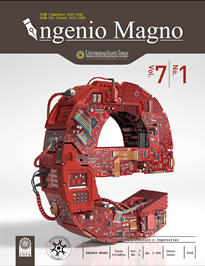Biological filter design, construction and development for Chromium contaminated water (case study)
Main Article Content
Abstract
Downloads
Article Details
DECLARATION OF ORGINIALITY OF SUBMITTED ARTICLE
With this document, I/We certify that the article submitted for possible publication in the institutional journal INGENIO MAGNO of the Research Center Alberto Magno CIIAM of the University Santo Tomás, Tunja campus, is entirely of my(our) own writing, and is a product of my(our) direct intellectual contribution to knowledge.
All data and references to completed publications are duly identified with their respective bibliographical entries and in the citations thus highlighted. If any adjustment or correction is needed, I(we) will contact the journal authorities in advance.
Due to that stated above, I(we) declare that the entirety of the submitted material is in accordance with applicable laws regarding intellectual and industrial property, and therefore, I(we) hold myself(ourselves) responsible for any complaint related to it.
If the submitted article is published, I(we) declare that I(we) fully relinquish publishing rights of the article to the University Santo Tomás, Tunja campus. As remuneration for this relinquishment of rights, I(we) declare my(our) agreement to receive two (2) copies of the edition of the journal in which my(our) article appears.
References
Asgari, G., Ramavandi, B., Rasuli, L. y Ahmadi, M. (2013). Adsorption from aqueous solution using a surfactant-modified Iranian zeolite: characterization, optimization, and kinetic approach. Desalination and Water Treatment, 51, 31-33.
Balasubramaniana, K., Arunachalam, K., Dasb, A. K. y Arunachalam, A. (2012). Decomposition and nutrient release of Eichhornia crassipes (Mart.) Solms. Under different trophic conditions in wetlands of eastern Himalayan foothills. Ecological Engineering, 44, 111-122.
Carreño, U. y Perdomo, F. (2015). Diseño, construcción y puesta en marcha de un sistema de tratamiento biológico con (Eichhornia crassipes) para la remediación de las aguas residuales procedentes de las curtiembres ubicadas en la cuenca alta del río Bogotá. X Convención Internacional sobre Medio Ambiente y Desarrollo. La Habana: Ministerio de Ciencia, Tecnología y Medio Ambiente de Cuba.
Chisutia, W. y Mmari, O. (2014). Adsorption of Congo Red Dye from aqueous solutions using roots of Eichhornia crassipes: kinetic and equilibrium studies. Energy Procedia, 50, 862-869.
Covarrubias, C., García, R., Yánez, J. y Arriagada, R. (2008). Preparation of CPB-modified FAU zeolite for the removal of tannery wastewater contaminants. Journal of Porous Materials, 15(4), 491-498.
Epstein, P. (2012). Weeds bring disease to the east African waterways. The Lancet, 351(9102).
Gómez, H. y Pinzón, G. (2012). Análisis de la mitigación del impacto ambiental en el lago del parque La Florida, por fitorremediación usando buchón de agua (tesis de especialización). Bogotá: Universidad Militar Nueva Granada.
Gopal, B. (1987). Aquatic plant studies 1. Water Hyacinth. Nueva York: Elsevier.
Lv, G., Li, Z., Jiang, W-T., Fenske, N. y Demarco, N. (2014). Removal of Cr (VI) from water using Fe(II)modified natural zeolite. Chemical Engineering Research and Design, 92(2), 384-390. Doi: 10.1016/j.
cherd.2013.08.003
Higuera, O., Escalante, H. y Laverde, D. (2005). Reducción del cromo contenido en efluentes líquidos de la industria del cuero, mediante un proceso adsorción – desorción con algas marinas. Scientia et Technica, 11(29).
Higuera, O., Arroyave, J. y Flórez, L. (2008). Diseño de un biofiltro para reducir el índice de contaminación por cromo generado en las industrias del curtido de cueros. Revista DYNA, 160, 107-119.
Leyva, R., Azuara, P., Díaz, F. y Guerrero, C. (2008). Adsorption of chromium(VI) from an aqueous solution on a surfactant-modified zeolite. Colloids and Surfaces A. Physicochemical and Engineering Aspects, 330(1), 35-41.
Lin, S., Guoxing, W., Zhongyuan, N., Diannan, L. y Zheng, L. (2012). Long-root Eichhornia crassipes as a biodegradable adsorbent for aqueous As(III) and As(V). Chemical Engineering Journal, 183, 365-371.
Tan, L., Zhu, D., Zhou, W., Mi, W., Ma, L. y He, W. (2008). Preferring cellulose of Eichhornia crassipes to prepare xanthogenate to other plant materials and its adsorption properties on copper. Bioresource Technology, 99(10), 4460-4466
Kasturiarachchi, J. C. (2014). Removal of nutrients (N and P) and heavy metals (Fe, Al, Mn and Ni) from industrial wastewaters by phytoremediation using water hyacinth (Eichhornia crassipes) under different nutritional conditions. Recuperado de http://dl.lib.mrt. ac.lk/handle/123/10239
Kumar, V., Motohide, M. y Miyake, M. (2008). Sorption properties of the activated carbon-zeolite composite prepared from coal fly ash for Ni2+, Cu2+, Cd2+ and Pb2+. Journal of Hazardous Materials, 160(1), 148-153.
Martínez, C., Torres, M. y García, R. (2013). Evaluación de la cinética de adsorción de Zn2+ y Cd2+ a partir de soluciones unitarias y binarias por raíces de Eichhornia crassipes y Typha latifolia. Avances en Ciencias e Ingeniería, 4(2), 1-14.
Mejía, Z., Valenzuela, S. y Aguayo, S. (2010). Adsorción de arsénico en zeolita natural pretratada con óxidos de magnesio. Revista Internacional de Contaminación Ambiental, 25(4), 217-227.
Pitcher, S. K., Slade, R. C. T. y Ward, N. I. (2004). Heavy metal removal from motorway stormwater using zeolites. The Science of the Total Environment, 1(334335), 161-166.
Poddar, K., Mandal, L. y Banerjee, G. C. (1991). Studies on water hyacinth (Eichhornia crassipes) – chemical composition of the plant and water from different. Ciencia, Tecnología y Futuro, 5(2).
Qiu, W. y Zheng, Y. (2009). Removal of lead, copper, nickel, cobalt, and zinc from water by a cancrinite-type zeolite synthesized from fly ash. Chemical Engineering Journal, 145(3), 483-488.
Velarde, H., Zavaleta, A. y Aguilar, Q. (2013). Estudio de la absorción del ion cromo VI con jacinto de agua (Echhornia crassipes). II Encuentro de Investigadores. Trujillo: Universidad de Trujillo.
Wang, S. y Peng, Y. (2010). Natural zeolites as effective adsorbents in water and wastewater treatment. Chemical Engineering Journal, 156(1), 11-24.
Zhou, W., Zhu, D., Lagdon, A., Li, L., Liao, S. y Tan, L. (2011). The structure characterization of cellulose xanthogenate derived from the straw of Eichhornia crassipes. Bioresource Technology, 100, 5366-5369.
Li, X., Liu, S., Na, Z. y Liu, Z. (2013). Adsorption, concentration, and recovery of aqueous heavy metal ions with the root powder of Eichhornia crassipes. Ecological Engineering, 60, 160-166.
Xia, H. y Ma, X. (2006). Phytoremediation of ethion by water hyacinth (Eichhornia crassipes) from water. Bioresource Technology, 97, 1050-1054.

